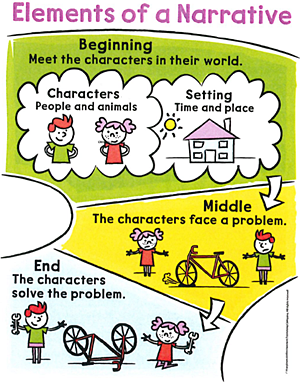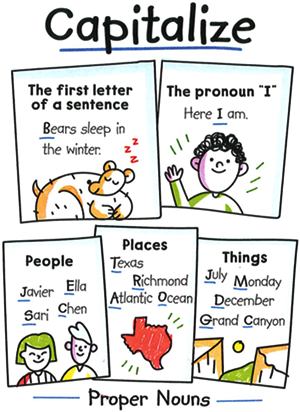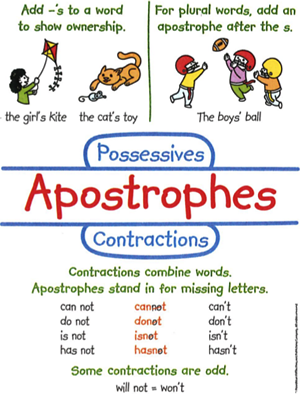Essay: Editing Steps
Essay: Editing Steps

Note: These are non-graded learning activities, so please do not submit them to the teacher.
In this Module, you will continue writing a personal narrative, which is one type of narrative. A personal narrative is a story about something that happened to the person telling the story.
When you edit, you will check for:
- capital letters,
- space between words,
- punctuation, and
- spelling.

Part 1: Capitalization
Let’s use the personal narrative A Good Deed on a Snowy Day
to practice finding singular and plural nouns.
The words day and school are singular nouns. Each names one thing. The words snowballs and neighbors are plural nouns. Each names more than one thing. Both plural nouns end in -s.
As you reread A Good Deed on a Snowy Day, write down the common nouns and put a star next to proper nouns.
Proper nouns must use correct capitalization. Read the chart about capitalization.
You should always capitalize:
- The first letter of a sentence: Bears sleep in the winter.
- The pronoun I: Here I am.
- Proper Nouns:
- People: Javier, Ella, Sari, Chen.
- Places: Texas, Richmond, Atlantic Ocean.
- Things: July, Monday, December, Grand Canyon.

Part 2: Contractions and Punctuation
Read the chart to learn how to use apostrophes.
Look back at A Good Deed on a Snowy Day to find words that use apostrophes. You can sort the words you find into two categories:
Possessives show ownership.
- To show ownership, add ‘s to a word.
- The girl’s kite is colorful.
- The kite belongs to the girl.
- For plural words, add an apostrophe after the s: The boys’ ball is new.
Using possessives can make writing more specific and concise.
Contractions
- Contractions combine words, and apostrophes stand in for the missing letters.
- I’ll is the contraction for I will.
- To form the contraction, the letters wi were dropped and the apostrophe was added.
Contractions can make dialogue sound more natural or a narrator sound less formal.
Part 3: Proofreading
Next, you will begin editing your draft. In addition to checking for correct use of capital letters, space between words, punctuation, and spelling, you will also need to:
- check for contractions and possessives that are incorrectly used or punctuated; and
- add possessives or contractions if their use will improve your story.
You may ask a grown-up for help, and use the Proofreading handout.
Save your work to continue on Day 3.
Texas Tech K-12
-
Address
Texas Tech Plaza | 1901 University Ave, Lubbock, TX 79401 -
Phone
(800) 692-6877 -
Email
ttuk12@ttu.edu

